


09/10/2013
FEATURE BY MATT SOMERFIELD
As the late fly-away season continues, the teams descended on the Yeongam circuit in Korea, the purpose built circuit which was lauded when it first entered the calendar for its semi street circuit appearance.
As the seasons rolled on it the once planned leisure city has yet to come to fruition and now the circuit finds its place on the 2014 calendar on the danger list.
The second of only three anti-clockwise circuits on the 2013 calendar (Singapore & Brazil are the others) you'll often hear it referred to as 'front limited' this is because the technical nature of the circuit dictates that you require a good front end on the car. This puts significant strain on the front-right tyre as the surface is pushed laterally across the circuit as the driver asks it to give up its grip.
Red Bull
In the wake of the comments levelled by Gian Carlo Minardi on what he believed to be some interesting differentials between Vettel and the rest of the field (even his team-mate Webber) at Singapore, I felt compelled to look at the technical intricacies of what makes the RB9 intrinsically faster than the competition. As the article highlights we cannot simply single out one aspect of the car and expect it to reveal answers but rather look at both the overall technicality of the car and Vettel's bond with it.
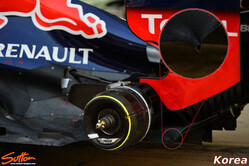 It did however become apparent in Korea that I had missed a design factor that Red Bull had put into practice after the change back to the 2012 tyre construction. The floor and diffuser has been a key feature in Adrian Newey penned cars over the years but none more so than this lineage of Red Bull cars. (Starting at the RB5).
It did however become apparent in Korea that I had missed a design factor that Red Bull had put into practice after the change back to the 2012 tyre construction. The floor and diffuser has been a key feature in Adrian Newey penned cars over the years but none more so than this lineage of Red Bull cars. (Starting at the RB5).
It's worth arguing that the RB9 in its current guise has an exhaust solution that is maximizing the amount of downforce at the same level as when the RB7 used a full EBD (exhaust blown diffuser) system. In the image (right) we can see where the periphery of the diffuser has been rolled up to create a 'scroll' this focuses the exhaust plume energy that is being made available at the diffuser’s tip, rolling it up into a vortex. This new, more concentrated vortex, entwines with the vortices generated within the diffuser giving a net gain. It's a complex matter (as we find with anything to do with diffuser flow but if you wish to know about it in more detail I have also completed a more expansive article on the subject)
As the season winds down teams have already started to shift focus toward their 2014 designs, with Adrian Newey an obvious absentee from the Red Bull pit-wall it's clear even the world champions are starting to work on next year’s challenger.
2014 throws up plenty of new design challenges not only with the new 'power units' that have been discussed at length but also some hefty aerodynamic revisions. Over the coming races I'm quite sure we will see teams operating a 'half way house' whereby they try to investigate potential avenues of development for next season. Invariably when investigating some of these avenues teams may also stumble across areas that may improve this year’s package also.
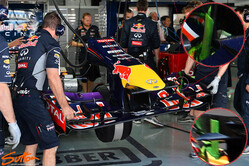 Mark Webber, seemingly Sebastian's test mule once again, did most of the assessment work during Friday's free practice sessions, before both drivers used the new front wing (pictured) for qualifying and the race. The wing features two vertical strakes behind the cascade element that will both vorticise and guide the airflow over the flaps and aid in the turning of the airflow around the front tyres. As I mentioned above these are likely a component born out the 2014 development plan as the team examines the options involved with running a narrower front wing.
Mark Webber, seemingly Sebastian's test mule once again, did most of the assessment work during Friday's free practice sessions, before both drivers used the new front wing (pictured) for qualifying and the race. The wing features two vertical strakes behind the cascade element that will both vorticise and guide the airflow over the flaps and aid in the turning of the airflow around the front tyres. As I mentioned above these are likely a component born out the 2014 development plan as the team examines the options involved with running a narrower front wing.
Ferrari
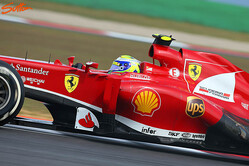 With Sebastian Vettel all but assured his fourth drivers’ title the Scuderia may be tempted to shut up shop for 2013 and concentrate its efforts on 2014. The problem however is the constructor's title. As Mercedes continues to harass the Maranello outfit for second both the prestige and the prize money is important.
With Sebastian Vettel all but assured his fourth drivers’ title the Scuderia may be tempted to shut up shop for 2013 and concentrate its efforts on 2014. The problem however is the constructor's title. As Mercedes continues to harass the Maranello outfit for second both the prestige and the prize money is important.
The team’s revisions in Korea were a little more lower key than usual, opting to simply go with them rather than running lots of back-to-back tests.
Having abandoned a development to the sidepod’s airflow conditioners used in Montreal the team once again bought a similar layout to this race. Unlike the ones used in Canada though these retain just the vertical elements (rather than curving over to meet with the sidepod and create a frame) but the way in which the conditioner is opened up to create more space between the elements mimics the Montreal element.
Also gone is the split at the very base of the conditioner that the team has been using since 2012, sprouting up from in front of the conditioner though is an 'r' vane which will invariably create a similar but further outreaching vortex.
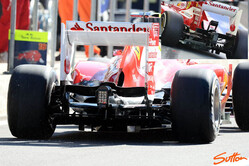 At the rear of the car the team once again changed the design of the beam wing to suit the characteristics of the Yeongam circuit with a sculpted variant designed to reduce drag at the outer sections. (Singapore configuration inset)
At the rear of the car the team once again changed the design of the beam wing to suit the characteristics of the Yeongam circuit with a sculpted variant designed to reduce drag at the outer sections. (Singapore configuration inset)
Mercedes
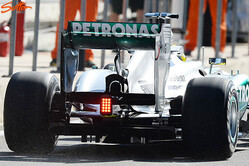 Much like Ferrari, the German team realises that its efforts are now set on beating the scarlet team to second in the constructors championship and concentrating on 2014, rather than allowing its drivers to chase Vettel for the drivers title.
Much like Ferrari, the German team realises that its efforts are now set on beating the scarlet team to second in the constructors championship and concentrating on 2014, rather than allowing its drivers to chase Vettel for the drivers title.
Other than a brief outing for its DRD during the free practice sessions the updates on the Silver Arrows were a little sparse
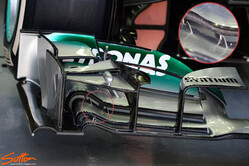 A slightly revised front wing featuring the type of small vertical strakes on the forward flap elements pioneered by Red Bull were of small solace to Mercedes fans.
A slightly revised front wing featuring the type of small vertical strakes on the forward flap elements pioneered by Red Bull were of small solace to Mercedes fans.
Lotus
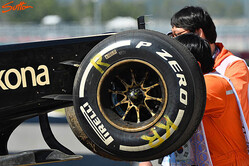 Having set about introducing a long wheel base version of the E21 at Monza its maiden race was Korea. Lengthening the chassis by around 100mm has an effect both mechanically (extending tyre life) and allowing more space aerodynamically. As we can see above the splitter has been extended forward and is indicated by the stay which has seen its orientation flipped.
Having set about introducing a long wheel base version of the E21 at Monza its maiden race was Korea. Lengthening the chassis by around 100mm has an effect both mechanically (extending tyre life) and allowing more space aerodynamically. As we can see above the splitter has been extended forward and is indicated by the stay which has seen its orientation flipped.
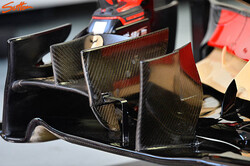 A minor front wing revision see's the cascade’s physical stay moved inboard of the element whilst a ‘dogleg’ assures the airflow in the region is also altered. The stay’s movement may be attributed to dynamic aerodynamic changes around the cascade that alter under load.
A minor front wing revision see's the cascade’s physical stay moved inboard of the element whilst a ‘dogleg’ assures the airflow in the region is also altered. The stay’s movement may be attributed to dynamic aerodynamic changes around the cascade that alter under load.
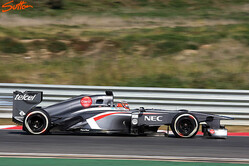 A fantastic defensive drive by Nico Hulkenberg saw the German replicate his best career finish. With the car providing a better qualifying and race platform over the last couple of races it has given both its drivers the opportunity to challenge.
A fantastic defensive drive by Nico Hulkenberg saw the German replicate his best career finish. With the car providing a better qualifying and race platform over the last couple of races it has given both its drivers the opportunity to challenge.
Sauber is one of the teams that has benefited from the change in tyre construction since Silverstone and ironically it coincided with the team’s adoption of the cross-under tunnel exhaust bodywork run by Red Bull and Lotus.
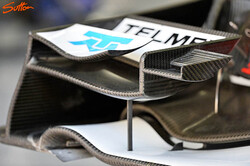 Like Mercedes, although a small revision, we see that the team has also furnished its front wing's mainplane with a small vertical strake pioneered by Red Bull.
Like Mercedes, although a small revision, we see that the team has also furnished its front wing's mainplane with a small vertical strake pioneered by Red Bull.
The original design decisions that led to the C32 also saw the team utilise both the spoon rear wing (as used in Korea) and DRD. When the team realised some of the errors it had made in designing the car with the original 2013 specification tyres it had to ditch these ideas.
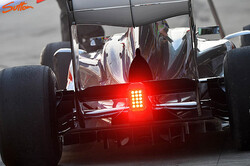 This was due to the inconsistent levels of downforce they were generating with the under-floor and diffuser whilst the rear wing which is designed to give both good medium speed downforce and low drag had to be sacrificed for a more conventional one.
This was due to the inconsistent levels of downforce they were generating with the under-floor and diffuser whilst the rear wing which is designed to give both good medium speed downforce and low drag had to be sacrificed for a more conventional one.
Learn more about Matt and check out his previous features, here